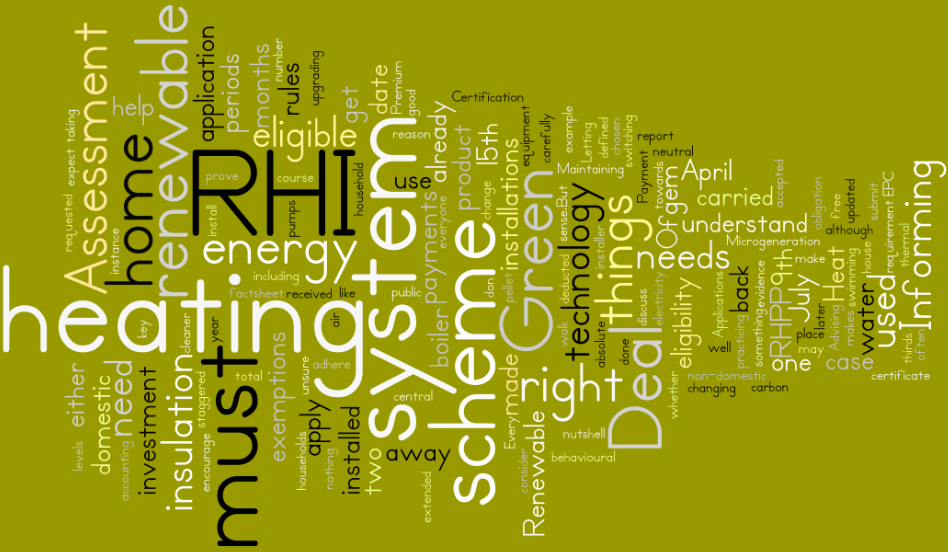
Domestic Renewable Heat Incentive Guide
Contents
- Section 1: Introduction
- It is Only for Renewable Heat Installations
- The Green Deal Assessment
- The Rules of the Scheme
- Your Responsibilities
- Section 2: The Eligible Technologies
- Biomass
- Ground Water and Air Source Heat Pumps
- Solar Thermal
- Section 3: In Depth: Biomass
- What is Biomass?
- How Can Biomass be Used Under the Domestic RHI
- Air Quality
- Health and Safety
- Sustainability
- How Much Will You Get?
- Section 4: In Depth: Heat Pumps
- What are Heat Pumps?
- How can Heat Pumps be Used Under the RHI?
- Seasonal Performance Factors
- How Much Will You Get?
- Section 5: In Depth: Solar Thermal
- What is Solar Thermal?
- How can Solar Thermal be Used Under the RHI?
- Eligible Systems
- How Much Will You Get?
- Section 6: The Domestic Renewable Heat Incentive and Your Home
- Basic Requirements for Properties
- The Energy Performance Certificate (EPC) and the Domestic RHI
- Are You Domestic? Advice for Home Businesses
- Insulation Requirements
- What About Other EPC Recommendations?
- Metering – Do You Need It?
- Section 7: The RHI for Existing Installations
- What is a Legacy Applicant?
- Eligibility Requirements
- When to Apply
- Section 8: Ready to Apply?
- Checklist of Eligibility Criteria
- How to Apply
- Checklist of Things You Will Need in Order to Apply
- When to Apply
- What Happens Next?
- Section 9: Why Some RHI Applications Will be Subject to a Manual Review
- Insulation Exceptions
- Applicants who Have Received Public Funding (not the RHPP)
- Self Build Properties
- Changes in Heat Pump Performance Calculations
- New Products
- Multiple Products
- Section 10: Accepted on the Domestic RHI? What Next
- The 6 Ongoing Obligations
- Annual Declarations
- Penalties for Rule Breaking
- Evaluation and Feedback
- Audit Checks
Domestic RHI Guide: Introduction
The Domestic Renewable Heat Incentive is a UK Government scheme to encourage the use of renewable heating technologies. Under the scheme, householders receive quarterly payments for a period of 7 years based on the amount of renewable heat their system produces. The Domestic RHI is targeted at homes off the gas grid but you don’t have to be off gas grid to apply.
The domestic RHI provides support for biomass, air source heat pumps, ground source heat pumps and solar thermal. The tariffs have been set at a level that reflects the expected cost of renewable heat generation over 20 years and should make renewable heating a viable option when set against the costs of conventional heating systems.
In this guide we provide information on the eligible technologies, what conditions you, your home, your heating system and your installer need to meet to qualify, how to apply, how the system will work once you are accepted and, of course, how much you will get paid. The actual tariff rates are different depending on the technology you install and the rates are included in the “In Depth” section for each technology.
The domestic Renewable Heat Incentive (RHI) has been put in place to encourage a switch towards renewable heating systems in homes. With heating accounting for around two thirds of a household’s total energy spend, switching to cleaner, cheaper sources of heating makes absolute sense. Before you jump into the application process for the domestic RHI, here are some of the key things to understand about the scheme.
It is Only for Renewable Heat Installations
Things like upgrading your boiler, changing from electricity to gas and installing central heating are not applicable. In a nutshell, the Domestic RHI will help you recoup more money from installations of:
The technology must be used for space and water heating in the home…
- Solar thermal
- Heat pumps (ground, water and air)
- Biomass boilers
- Wood pellet stoves with a back boiler
The technology must be used for space and water heating in the home, and should not be for the purpose of heating, for example, a swimming pool or for any non-domestic use. Your chosen technology not only needs to be of the right type, it also needs to be an eligible product as defined by the scheme. You or your installer can check the product eligibility list if you are unsure.
Renewable heating is not right for everyone, and you should consider carefully whether it is right for your home and family before taking things further. Your home needs to be well insulated and you should already be practising good behavioral energy efficiency to get the most from your investment.

The Green Deal Assessment
Every household who wants to apply to the RHI must have a Green Deal Assessment carried out. The Green Deal Assessment will help you to decide which, if any, renewable heating technology is right for you. If you have already had a Green Deal Assessment, you won’t need to have another.
If insulation is recommended in your Green Deal report, you will need to have this carried out before you will be eligible for the RHI. There are some exemptions to the insulation requirements, which we’ll discuss in a later section.
If you have made the requested improvements to the insulation levels in your home, you will need to obtain an updated EPC to prove you have had the work done.
The Rules of the Scheme
There are a number of rules you need to understand and adhere to in order to be eligible for the scheme.
- You must own the heating system
- You must either own or occupy the property which the system is being used in
- The system must be certified under the Microgeneration Certification Scheme (MCS)
- The system should not have been in use before it was commissioned (according to the date on your MCS certificate)
- Commissioning must have been on or after 15th July 2009
- Applications must be made within 12 months of the commissioning date, unless you installed your system before the scheme started, in which case you have a year from the launch to make your application (by 9th April 2015)
- Those who installed since 15th of July 2009 but before 9th April 2014 and received a Renewable Heat Premium Payment (RHPP) have staggered dates in which they can apply to the RHI. These are published in an Ofgem factsheet here.
- Any public grant, including the RHPP, will be deducted from the RHI payments over the course of 7 years.
Your Responsibilities
It’s not often you get something for nothing, and in the case of the RHI you don’t walk away obligation free either. If you are accepted onto the scheme and start to receive payments for your renewable investment, Ofgem do expect one or two things back from you. These include:
- Maintaining the heating system and any metering equipment used
- Informing them of any periods where the system is not functional, for instance if you are awaiting a repair
- Informing them if you sell your house
- Informing them of any changes to your heating system
- Letting them know if you plan to be away from your home for extended periods (6 months or more)
- Advising them of any change in circumstances which may affect your eligibility for the scheme
We will cover more of your responsibilities and obligations in the ‘Accepted on the RHI? What next…’ section.
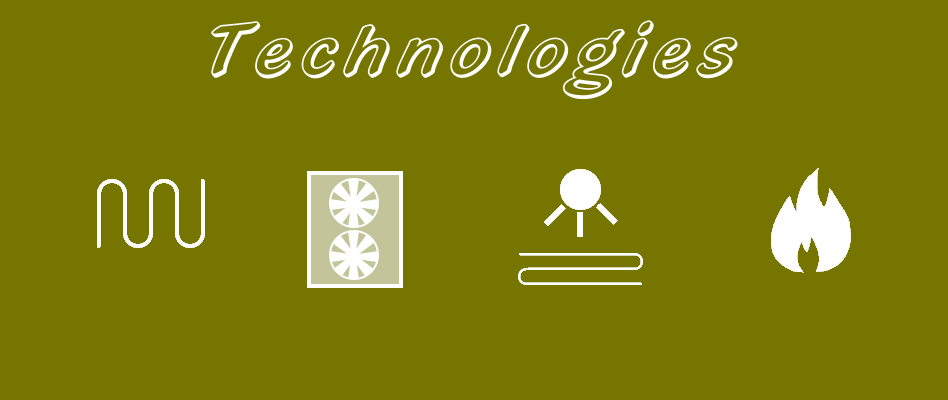
Section 2: The Eligible Technologies
There are four main technologies which are eligible for the RHI. These are:
Installations must be certified under the Microgeneration Certification Scheme (MCS). You also need to check that the specific product you are installing is eligible, as per Ofgem’s product eligibility list.
- Biomass boilers and pellet stoves
- Ground source heat pumps
- Air source heat pumps
- Solar thermal systems
There is no particular limitation set on the size of your system or the capacity for generation, but it does need to be certified under the Microgeneration Certification Scheme (MCS). You also need to check that the specific product you are installing is eligible, as per Ofgem’s product eligibility list.
Here, we discuss each eligible technology in more detail, and the permitted and non-permitted uses of each under the RHI.
Biomass
In order for biomass to be eligible under the RHI, the system needs to provide space heating to the home. The system can use a biomass boiler for solid biomass, or a biomass stove for pellets. Biomass stoves must connect via a heat exchanger to a wet central heating system – i.e. to radiators around the home.
 Fiona James / CC BY 2.0
Fiona James / CC BY 2.0
Biomass installations are permitted to use immersion heaters or supplementary electric heaters to top up or provide back up to the main water and space heating. No other fossil fuel input is allowed. The system must also meet air quality requirements, and must have been issued with an RHI emissions certificate before they will be accepted onto the scheme.
Must: Use appropriate fuel, comply with air quality requirements, supply heat via liquid.
Must not: Be designed to generate heat to cook food.
Uses: Space OR space and water heating.
More on Biomass: In Depth: Biomass and the Domestic RHI.
Ground, Water and Air Source Heat Pumps
Heat pumps will only be accepted onto the RHI scheme if they use liquid to distribute heat around the home. This usually means they need to be connected into underfloor heating or radiators. They can also be used for heating water for the home. Heat pumps that blow warm air around the house are not eligible.
Ground source heat pumps draw heat from the ground and distribute it around the home. They can draw heat from the earth, from water under the earth or from standing water such as ponds and lakes. Water source heat pumps are treated the same as ground source for the RHI. The heat pump must have a compressor which is powered by electricity to be eligible; gas compressors are excluded. Find out more about ground source heat pumps in our technology guide.
Air source heat pumps do the same job as ground source, but extract heat from the ambient air temperature for use in the home. They also must have an electrical compressor rather than a gas driven one, and should not be designed to use exhaust heat from buildings or appliances. Read more about air source heat pumps in our technology guide.
Seasonal performance factors (SPF) are a description of how much electricity the heat pump requires in order to produce heat. The minimum SPF for the RHI is 2.5. If your heat pump is installed after 9th April 2014, your installer will use the ‘Heat Emitter Guide’ to calculate the SPF. If your system was installed prior to 9th April 2014, you will be assigned an SPF of 2.5. If you believe your system performs better than this, you can contact an MCS installer to have your systems performance recalculated. It is well worth doing this, as it could significantly affect your payments.
Must: Have electrical compressor, use liquid to distribute heat, have a minimum SPF of 2.5
Must not: Be designed to use waste heat from an appliance or building.
Uses: Space OR space and water heating.
More on Heat Pumps: In Depth: Heat Pumps and the Domestic RHI.
Solar Thermal
There are two main types of solar thermal system which are eligible for the RHI at the present time. These are:
- Flat plate collector systems: liquid filled flat plates which collect heat from the sun and distribute it via a heat exchanger.
- Evacuated tubes: Highly efficient solar collector tubes which work in the same manner.
Solar systems must be installed only for the purpose of supplying hot water to the home. This means that systems which also supply heat to swimming pools, for space heating or for any other purpose than domestic hot water (DHW) will be deemed ineligible.
Must: Be flat plate or evacuated tube.
Must not: Be used for space heating, heating swimming pool, generating electricity or any other non domestic hot water purpose.
Uses: Water heating ONLY.
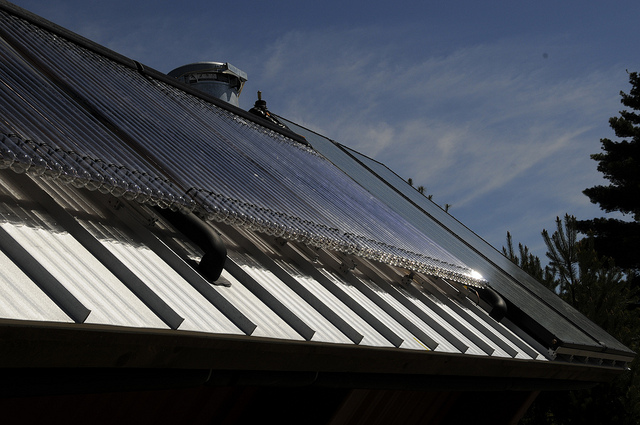 The Wild Center / CC BY-NC 2.0
The Wild Center / CC BY-NC 2.0
More on Solar Thermal: In Depth: Solar Thermal and the Domestic RHI.

Section 3: In Depth: Biomass and the RHI
Here we look at what exactly biomass is and how it can be used in order to be eligible to claim Domestic RHI payments, as well as how much you can expect to get.
What is Biomass?
Biomass is a term used to describe the use of organic material such as wood to produce energy. The term can cover a range of technologies, from room heaters or wood burners to biomass boilers connected to wet central heating systems. However, only some of these are eligible for the RHI payments. For more general information on biomass, see our guide to biomass on this website.
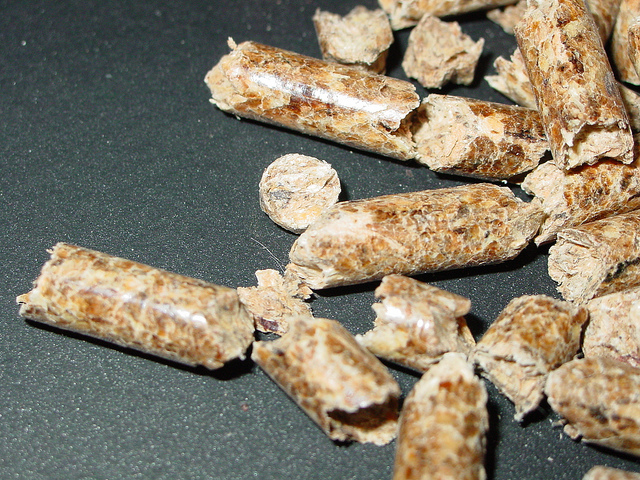 Alternative Heat / CC BY 2.0
Alternative Heat / CC BY 2.0
How Can Biomass be Used Under the RHI?
The payment rate for the Domestic RHI for biomass installations is set at 7.01p per kWh of heat produced (March 2021).
For the purposes of the RHI, biomass must be used to provide space heating and can also be used to make hot water for use in the home. Applicants can select from biomass boilers which use solid fuel such as logs, or biomass stoves which use pellets to produce heat. Stoves should be designed with an in built heat exchanger to distribute heat around the home using a liquid, for example through radiators.
Any biomass installation must not be used to cook food, so things like Aga’s and biomass fueled range cookers are not eligible for the RHI funding. You can supplement biomass heating with some fossil fueled technologies. For instance, you may want to combine your biomass system with an electric immersion heater for back up for your domestic hot water. You could also use supplementary electric heaters as long as the control of these is integrated with your biomass heating system. No other fossil fueled input is allowed, apart from for the ignition of the biomass unit.
Air Quality
OFGEM have set some requirements for compliance with air quality standards. This sets a limit on the emissions your biomass installation can produce. Emissions of particulate matter (PM) are not allowed to exceed 30g per gigajoule of heat, and emissions of NOx (oxides of nitrogen) must not be more than 150g per gigajoule of heat output.
You won’t be expected to measure these yourself, and the simplest way to ensure your chosen system is compliant is to choose a technology off the product eligibility list which already has an RHI Emissions Certificate. You should easily remain compliant with this requirement if you:
- Choose a technology on the eligible products list
- Use the fuel type which is specified on the emissions certificate
- Do not use fuels which exceed the moisture content specified
- Use your system according to manufacturer’s instructions
You will need to stick to these rules for the seven years that you are receiving payments and will need to send back a declaration every year that you are adhering to these rules. OFGEM may ask you for proof of compliance, so it’s worth keeping hold of things like receipts for fuel or annual statements to show them.
If you already have your system in place and are applying to the RHI as a legacy applicant, you will not need to meet these requirements.
Health and Safety
You should make sure you have well laid plans in place for the safe storage of your biomass fuel. The Health and Safety Executive (HSE) have helpfully put some guides online about how to store bio fuels safely. You should also consult your installer on how to use your system safely.
Sustainability
From the autumn of 2014, OFGEM will be putting in place requirements for sustainable sourcing of fuels too. These requirements are likely to apply to everyone, both new applicants and those who already have systems in place. This means there may be restrictions on who you can buy your biomass fuel from, so for the time being it is better not to enter into a long term supply contract with any one provider until the list is published.
How Much Will You Get?
The Domestic RHI tariff biomass installations is set at 7.01p per kWh of heat produced (March 2021). Once you’ve joined there will be no change to your tariff rate apart from annual adjustments to keep payments in line with the Consumer Price Index.
As biomass is difficult to meter, your payments will be set based on the annual heat load calculated when you have your Energy Performance Certificate (EPC) produced. As an example, a house with an estimated annual heat load of 15,000 kWh will receive £1,032 per year, paid in quarterly sums.

Section 4: In Depth: Heat Pumps and the RHI
Under the Domestic Renewable Heat Incentive (RHI), heat pumps can be air source, ground source or water source. As long as they meet the requirements of the scheme, you will be able to claim your payments. Here we look at what heat pumps are and how you can use them to remain eligible for the Domestic RHI.
To be eligible for RHI payments, heat pumps must deliver heat via a liquid such as a wet central heating system or underfloor heating system. This means air to air heat pumps are not eligible for payment.
What are Heat Pumps?
Heat pumps are essentially units that collect the ambient heat from another source, such as the air or ground, and compress it to raise the temperature until it becomes useful heat for the home. There are two types of heat pumps:
Air source heat pumps: These draw the heat out of the ambient air around them and then use it to heat the home. They can either do this via a central heating system, known as air to water, or via a warm air heating system, known as air to air. Air to air heat pumps are not currently eligible to receive the domestic RHI.

Ground source heat pumps: These use buried pipes filled with a heat exchanging liquid to draw warmth from the ground or, in the case of water source heat pumps, from the water in a lake or pond. They connect into a wet central heating system to provide heat for the home, and can also be used to provide domestic hot water too.
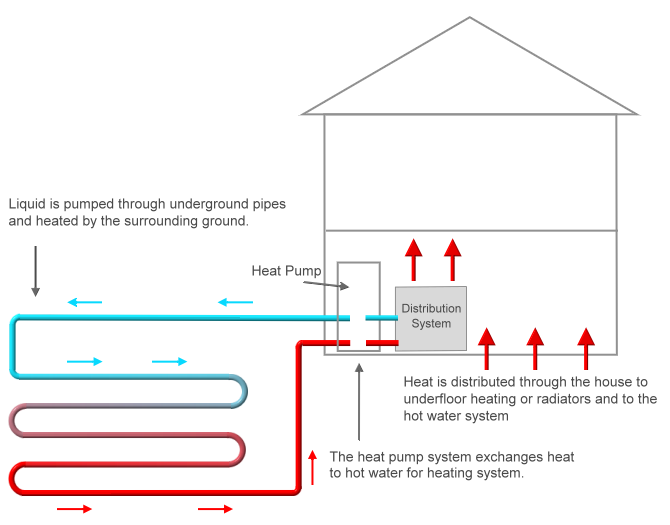
For more in depth information on these technologies, see our guide to ground source heat pumps and air source heat pumps on this site.
How can Heat Pumps be Used Under the RHI?
To be eligible for RHI payments, heat pumps must deliver heat via a liquid such as a wet central heating system or underfloor heating system. This means air to air heat pumps are not eligible for payment. Other specific requirements for each type of heat pump are:
- Ground and water source: Must use a compressor, and the compressor must be driven by electricity. Gas driven compressors are not allowed.
- Air source: Must also use an electrically driven compressor and may not be designed to use exhaust heat from appliances or building ventilation systems.
To help choose a product that is deemed by OFGEM to be suitable for the RHI, consult OFGEM’s product eligibility list and ensure your chosen technology is on there.
Seasonal Performance Factors
All heat pumps require an amount of electricity to work. The compressor and pump use electricity to produce heat, which usually comes from a non-renewable source. However, the technology is still classed as renewable / low carbon because the amount of electricity required to generate heat is significantly less than the amount of heat obtained from the device. The ratio of electricity input to heat output is known as the coefficient of performance.
To calculate the overall efficiency of the heat pump in terms of how much electricity is used versus how much heat is produced, installers and manufacturers use a Seasonal Performance Factor (SPF). This is calculated from the coefficient of performance (COP) and the variation in seasonal ambient temperatures. You don’t need to know how to do this calculation yourself, as your heat pump will be allocated an SPF number based on the Heat Emitter Guide star ratings by your installer.
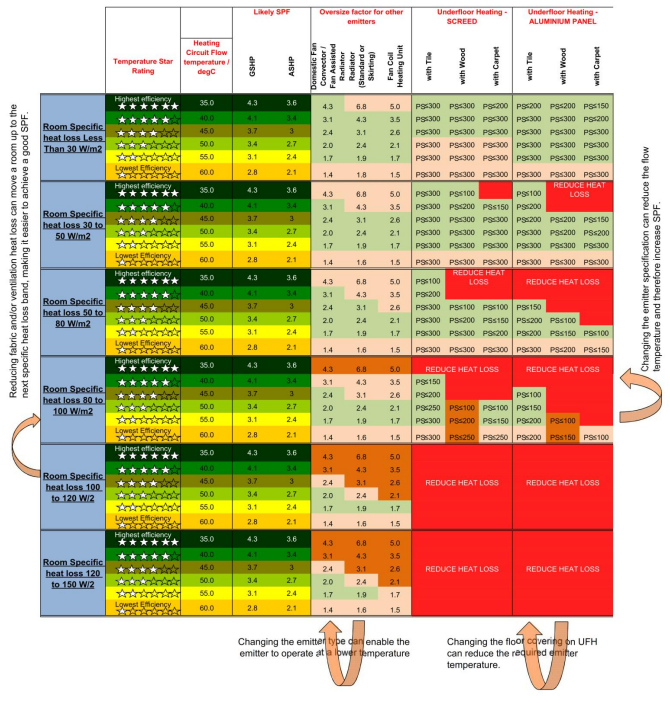
You can read more about the Heat Emitter Guide and the ratings system here, but you don’t need to know the system in detail to benefit from the RHI. What is important to you is that you comply with the RHI requirements of having a heat pump with an SPF of 2.5 or more.
Please note these two important points regarding your SPF allocation:
1. Your RHI Payments are calculated on this number: This means that if you think your heat pump is performing better than the number you have been allocated, you could be missing out on money. You can ask your installer to reassess the performance of your system and complete the SPF calculation template if you think your SPF is wrong.
2. Legacy applicants will be allocated SPF 2.5: This means that if you had your system commissioned before the Domestic Renewable Heat Incentive scheme officially launched, you will be given the lowest eligible SPF number. You should ask your installer to perform an assessment of the system to get your real SPF number, as you will miss out on payments otherwise.
How Much will you Get?
The tariff rate for the RHI for heat pumps (March 2020) is set at 10.92p per kWh of heat produced for air source heat pumps, and at 21.29p per kWh of heat produced for ground source. Once you’ve joined there will be no change to your tariff rate aside from standard annual adjustments to keep payments in line with the Consumer Price Index.
You won’t need metering for heat pumps unless they are being used in conjunction with some other system. If you intend to use another heat source, such as biomass or even fossil fuel, to ‘back up’ or support your heat pump generated energy, you will need to have metering installed.

Section 5: Solar Thermal and the Domestic RHI
The last of the eligible technologies for the Renewable Heat Incentive (RHI) is Solar Thermal. Here we look at what exactly solar thermal is and how it can be used in order to be eligible to claim RHI payments, as well as how much you can expect to get.
What is Solar Thermal?
Solar thermal refers to the process of collecting heat energy from the sun and using it to produce domestic hot water for the home. Solar thermal usually works using panels attached to the roof of your home, although panels can be wall mounted or even placed on a shed or in the garden if your outside space is not too shaded.
For more information on solar thermal and how it works, see our guide to solar thermal on this site.
How can Solar Thermal be Used Under the RHI?
For the purposes of the RHI, solar thermal can only be used to generate hot water for use in the home. It cannot be used to heat water for swimming pools, to provide space heating or for any other purpose than domestic hot water. You must also not use systems which also produce electricity.
Solar thermal refers to the process of collecting heat energy from the sun and using it to produce domestic hot water for the home.
The eligible systems are:
- Liquid filled flat plate collectors
- Evacuated tube systems
For a specific list of the eligible technologies under the RHI, have a look at OFGEM’s product eligibility list.
How Much Will You Get?
The tariff rate for the RHI for solar thermal installations is set at 21.49p per kWh of hot water produced (March 2021). Once you’ve joined there will be no change to your tariff other than standard annual adjustments to keep payments in line with the Consumer Price Index. You do not need to have any metering installed for your solar thermal system, even if it is used alongside another renewable technology. The rate will be set in line with your EPC results and the size of system you have installed.

Section 6: The Domestic Renewable Heat Incentive and Your Home
Image source: Ano Lobb cropped / CC BY 2.0
Before you can apply for the Renewable Heat Incentive (RHI), you need to make sure your home is eligible. The scheme has been designed to encourage the uptake of renewable heating technologies by householders, and this means it is only eligible for those who are using their low carbon heat system to heat a domestic property.
The Basic Requirements
Before you can apply to the RHI you will need to have a Green Deal Assessment. If this assessment reveals any areas of insulation that need upgrading, it is mandatory that you complete these prior to applying to the scheme.
To be eligible for the Domestic RHI you must:
- Be using renewable heat to heat a single domestic property
- Be able to get a domestic Energy Performance Certificate (EPC)
- Be the owner or occupier of the property
- Be installing an eligible size and type of technology
- Be applying for an installation commissioned on or after 15th July 2009
- Have your installation completed by an MCS certified installer
- Apply within 12 months of the commissioning date
- Be contributing financially to the cost of the heating system
The Energy Performance Certificate (EPC) and the Domestic RHI
An Energy Performance Certificate gives information about the energy use of a property, along with recommendations on how to reduce consumption in the future. If you have recently sold, rented or bought a home you will have seen one of these already.
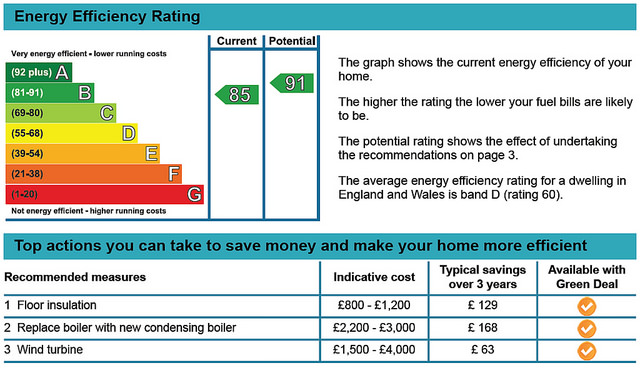 London Permaculture / CC BY-NC-SA 2.0
London Permaculture / CC BY-NC-SA 2.0
For the purposes of the RHI, OFGEM require that you obtain a domestic EPC to prove that your property is considered to be domestic and not a business. Most homes which serve as the main residence for a single household will be considered domestic and will have no problem obtaining an EPC for the house. However, it can get more complicated if you run a business at home or have a business attached to the premises.
Are You Domestic?
If your home set up is more complicated or if the renewable heating system supplies heat to more than one building, it can be tricky to know whether to apply to the domestic or non-domestic section of the RHI, or indeed if you are eligible for either. Complex situations are addressed by OFGEM on a case by case basis. As a general rule:
- Homes with a home office in the same building will generally be eligible for the domestic RHI as long as the EPC covers the whole building including the office.
- Homes will annexes which contain a business will usually be eligible, as long as all areas of the building are covered by a domestic EPC.
- Homes that have a main house and then an outbuilding which is considered to be ‘self-contained’, i.e. to have its own bathroom and kitchen, will usually have separate EPC’s done for each building. In this case the domestic Renewable Heat Incentive would not be applicable, although you may be able to apply to the non-domestic stream.
- Homes with a main building and several outbuildings which are all heated by the same technology would also not be eligible for the domestic RHI, but could apply to the non-domestic stream instead.
Whether your home is located within a larger commercial premises, or if the heat your technology produces is used for both domestic and business needs, you should talk to your EPC advisor to find out what route to take. There is more information on determining if your home is ‘domestic’ or not on the OFGEM website.
Insulation Requirements
Before you can apply to the RHI you will need to have a Green Deal Assessment. If this assessment reveals any areas of insulation that need upgrading, it is mandatory that you complete these prior to applying to the scheme. If you have installed your loft and cavity wall insulation, your Green Deal Assessment will confirm if it is up to the current standards. If you have not, then you must install loft and cavity wall insulation to be eligible for the RHI.
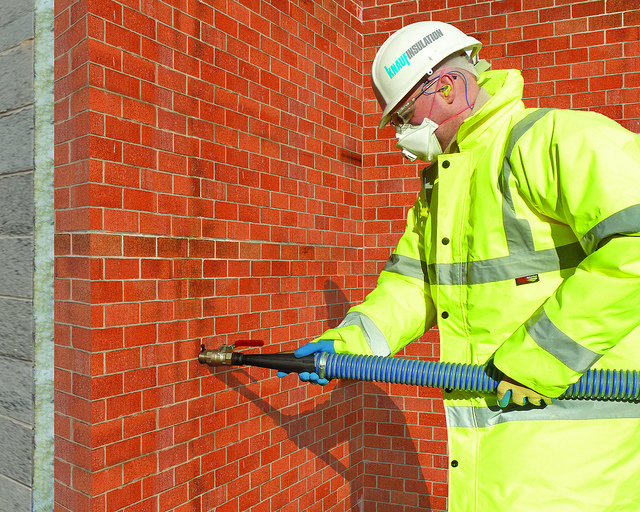 Knauf Insulation / CC BY-NC-SA 2.0
Knauf Insulation / CC BY-NC-SA 2.0
Once you’ve had your house insulated, you need to have a new Energy Performance Certificate issued before you can apply to the RHI.
What if You Can’t Have it Done?
In some situations, insulation may be recommended on your Green Deal Report although you cannot have it done. This may be because your home is listed, in a conservation area or because your home houses a protected species. In this situation you can obtain an exemption to allow you to apply to the RHI anyway, but you will need to get evidence from the appropriate body before submitting your application. See this page of the OFGEM site for advice on what evidence to obtain and how to do it.
What if it’s Difficult to Do?
If you find that bringing your insulation up to standard is difficult, you may be able to get financial help towards the cost. If you have, for instance, nonstandard cavity walls or hard to treat walls, you may be able to get funding through the Energy Companies Obligation (ECO) scheme.
What if You Think it’s Wrong?
If you think the recommendation has been made in error, for instance if the EPC has recommended cavity wall insulation but you have solid walls, you can ask your EPC assessor to re-do the assessment.
What About Other EPC Recommendations?
There may be other recommendations in the EPC such as installing double glazing or solid wall insulation. However, it is up to you whether you take action upon these recommendations. They do not need to be completed for the purpose of applying to the RHI.
Metering – Do You Need It?
In most cases there will be no need for metering to be installed. Solar thermal will never require metering and in straightforward installations of heat pumps or biomass metering will not normally be needed. There are three distinct situations where you will need to be metered:
1. If you have another heating system in the house
If you have a backup heating system such as an oil boiler, gas boiler or electric heaters, you may need to have your renewable system metered so a correct assessment of the amount it is contributing can be calculated. If you are using more than one renewable heating system for room heating, then you may also need to have metering done. You will not need to be metered if your back up heating is only for a single room (such as a plug in electric fire), if it is integrated with your renewable heating system (such as an immersion heater or supplementary electric heater built into a heat pump or biomass system) or if it is a heat recycling system.
2. If your home is not always occupied
If you live in your home for less than half the year, you will need to have your technology metered. This includes properties with tenants where the landlord expects it to be empty for six months or more each year, as well as second homes and holiday homes.
3. If you have a biomass boiler which does not heat the whole house
If your biomass boiler is not sized to provide whole house heating, then it will need to be metered.
If you think you fall into any of these three categories, it is worth having a read of the OFGEM guidance on metering requirements so you know what you might need to do. Talk to your installer too about whether you will need to be metered, and factor the cost of the meter into your calculations when looking at how much your system will cost.

Section 7: The Domestic RHI for Existing Installations
Image source: Niklas Morberg altered / CC BY-NC 2.0
The Renewable Heat Incentive (RHI) for domestic householders officially opened on 9th April 2014. However, some people who had their systems installed before this will still be able to get onto the scheme. These are known as ‘legacy applicants’, and here we will look at what this means and how they can apply to the RHI too.
What is a Legacy Applicant?
Anyone who has had their renewable heating system installed before the scheme launched but since the 15th July 2009 is eligible to join the RHI as a legacy applicant. Whether you received a Renewable Heat Premium Payment (RHPP) or not, you will still need to make an application to the scheme to start receiving your payments. The requirements for these applicants is mainly the same as for new applicants, but there are a few differences.
Make sure your legacy application is completed before 9th April 2015, as applications made after this may not be accepted onto the scheme.
Eligibility Requirements
Eligibility requirements are the same as for new applicants, except:
- Systems do not need to meet the current MCS standards. As long as they met standards at the time of commissioning, this is enough.
- Biomass applicants do not need to meet the current air quality standards.
- Heat pump applicants are automatically allocated the minimum Seasonal Performance Factor (SPF) of 2.5 unless you have it reassessed before you apply.
OFGEM still need you to supply the MCS certificate number, a Green Deal Advice Report and an EPC for your home.
When to Apply
If you did not receive funding through the RHPP scheme then you can apply to the RHI right away. If you did get the RHPP funding, then OFGEM have staggered the dates when you can apply to the RHI to avoid the system becoming clogged up with legacy applicants. The dates are:
- RHPP application made before 20th May 2013: Apply from 9th July 2014
- RHPP application made on or after 20th May 2013: Apply from 9th October 2014
Make sure your legacy application is completed before 9th April 2015, as applications made after this may not be accepted onto the scheme. No matter what date you have been allocated for your application slot, you will receive the tariff rate applicable at the time the scheme opened, even if OFGEM has reduced the RHI tariffs by then as part of their budget control.

Section 8: Ready to Apply?
Think you’re ready to apply to the Renewable Heat Incentive (RHI)? We’ve put together some checklists and advice to help you get your application completed successfully.
To join the scheme you need to meet the eligibility criteria. Here are the main things you need to ensure you comply with:
- Eligibility Criteria Checklist
- You must have an EPC (completed as part of your Green Deal Assessment)
- You must have a Green Deal Advice Report
- If your report recommends loft and cavity wall insulation, you must have this done
- You must own the heating system
- You must own or occupy the house
- You must use an eligible technology
- You must make some financial contribution yourself to the heating system
- If you need to have metering, you should have an eligible meter installed
- Heat generated must be for use in your home for space and water heating only
- The system must be MCS certified
- No part of the heating system can have been previously used – refurbished systems are ineligible
- The system must have been commissioned on or after 15th July 2009
- You must apply within 12 months of the commissioning date, unless you are a legacy applicant in which case you must apply by 9th April 2015
How to Apply
When you are ready to apply, you need to go to https://domesticrhi.ofgem.gov.uk/apply and start the application process. The application is a basic two page form which will ensure you are eligible to apply and then ask you about the system you are installing.
- Initial questions: These questions ask about you, your home and your heating system. This is a quick way to check you are eligible to go on to the full application.
- Personal questions: The next page asks for your personal details and bank details, as well as any additional information that may be required. If there is no additional information needed, you may get confirmation on screen that you have been successful straight away.
The application can be made by the owner of the heating system and home. If the home or heating system is owned by a number of people, then one nominated person should be the primary contact for the purposes of the RHI.
Organisations Applying to the Domestic RHI
Organisations can apply to the domestic RHI, but will need to meet certain criteria, including:
- Supplying a named representative
- Providing a letter of authorisation for the representative to act on behalf of the organisation
- The named representative supplying personal information such as name and address
- Registered social landlords (RSLs) will need to provide registration number, organisation name and registered address
Checklist of Things You Will Need in Order to Apply
Here’s a quick checklist of things you will need to complete your application:
- Things You’ll Need For Your Application
- Personal information
- Bank details
- MCS certificate number
- Green Deal Advice Report number
- Energy Performance Certificate (EPC) number
If the system rejects your EPC, MCS or Green Deal number, it could be that the data from the assessor or body has yet to be uploaded to the OFGEM system. Wait at least 10 days from receiving your report or certificate to ensure they have the number on their database.
When to Apply
Your application date is the date which you submit your application to OFGEM with all required information. This date is important as it could affect the tariff rate you receive and the date your payments get backdated from.
If you are required to send further information, you will have 28 days to do this. If you need to get another EPC or evidence of metering, you will have up to three months to send it back. If you exceed this time frame, you risk losing the application date meaning you could be put onto a lower tariff.
Essentially it is a case of the sooner the better, so get your application started as soon after commissioning as you can. Legacy applicants who received the Renewable Heat Premium Payment may have to wait to apply, but will already have the launch tariffs secured for them.
What Happens Next?
Once you submit your application, there are three main outcomes:
- Acceptance: If all of your details can be verified automatically, you will receive notification of acceptance instantly on the website. You will also be sent an email confirming your heating system information as supplied, as well as information about when your payments will begin and end.
- Manual review: If your application is ‘under review’, this just means OFGEM wish to manually check your application to confirm eligibility. They may ask you for additional information, or it may just be a random manual check for audit purposes.
- Rejected: If your application is rejected you will be advised of the reason why. Often this is something you can change, and you will be able to reapply to the scheme once you have resolved the issue.

Section 9: Why Some Applications Will be Subject to Manual Review
For the majority of applicants to the Renewable Heat Incentive (RHI), things will be fairly straightforward. As long as you have the required information and have ensured you stick to all the requirements of the scheme, you should be accepted without trouble. However, in a few cases there is a need for OFGEM to conduct a manual review of your application. Mainly this will be due to:
In any situation, it is a good idea to hold onto all your paperwork and product information so you can quickly answer their queries.
- Insulation exceptions
- Applicants who have received public funding (not the RHPP)
- Self-build properties
- Changes in heat pump performance calculations
- New products
- Multiple products
We will look at each area in more depth to see what is involved and what to expect if you are advised your application is under review.
Insulation Exceptions
In some cases you will be exempt from taking action on the insulation requirements detailed in the EPC you have received for your property. If you think you are exempt, you will need to obtain evidence from the relevant authority and submit them to OFGEM for your application to be approved. Exemptions are allowed if:
- The property is a listed building: For this you will need to gain confirmation from a relevant authority, such as your local planning department, Historic Scotland, CADW or English Heritage.
- The property is in a conservation area: Again you will need to confirm this with the local authority or your relevant conservation organisation.
- Your home houses a protected species that would be harmed by insulation: This is typically species of bats who would be disturbed during the loft insulation process. You can get confirmation of this from Natural England, Natural Resources Wales or Scottish Natural Heritage. You can also contact a chartered ecologist for help through the Chartered Institute of Ecology and Environmental Managers.
- Environmental conditions make your home unsuitable for insulation: This normally applies to properties in very exposed conditions that are subjected to driving rain and therefore unsuitable for cavity wall insulation. You will need to have a chartered surveyor visit your home and prepare a report.
- Structural conditions make your home unsuitable for insulation: You will need to have a chartered surveyor visit your home and prepare a report.
If you wish to apply for an insulation exemption, you will need to have the appropriate body complete the insulation exemption template in support of your claim.
Applicants Who Have Received Public Funding (not the RHPP)
Grants received from a public source that have helped to pay for your heating system will need to be deducted from your RHI money. The total amount of the grant will be split over all your payments, so if you received £1,000 in grant you would then receive £35.71 less on every quarterly payment over the seven years.
OFGEM consider funding from the National Lottery as public funding, as well as grants from public bodies and those distributing funds on behalf of public bodies. They will assess each application on a case by case basis.
Self-Build Properties
The RHI is not eligible to new build homes that have had renewable technologies built into them before they were first occupied. The only exception to this rule is if the property was self-built. To be classed as a self-build, the home must:
- Have been built by the owner themselves or financed by the owner
- Have a heating system commissioned before the house is occupied
- Be owned by the first owner and all subsequent owners as individuals and not wholly or partly owned by a company, organisation or any person who is not an individual
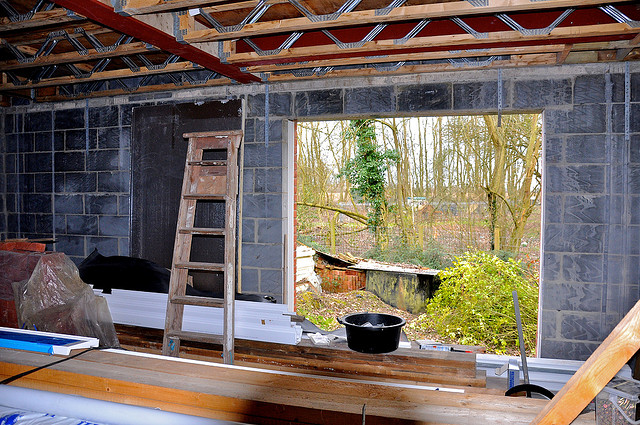 Martin Pettitt / CC BY 2.0
Martin Pettitt / CC BY 2.0
If you are applying as a self-builder, you will be required to provide proof of eligibility. This could be proof of your self build mortgage or insurance, a copy of your VAT exemption from HMRC or a copy of your community infrastructure levy exemption letter.
Changes in Heat Pump Performance Calculations
Legacy heat pump applicants will automatically be assigned an SPF of 2.5 because this will not have been calculated by the installer at the time of commissioning. If you think your heat pump is likely to be more efficient than this, you can arrange for an MCS installer to reassess your installation and provide a new SPF figure. You need to do this before you are accepted onto the scheme, and will need to get a Legacy SPF Calculation Template filled out by the installer.
New Products
If the technology you have chosen is not on the product eligibility list, you may need to supply further information on the product so OFGEM can assess its suitability.
Multiple Products
If you are installing more than one product you will need to provide additional information to support your application. Depending on what type of product they are and when they were commissioned (first operational) you may be able to claim for both or just one of the products.
For instance:
- Two or more of the same product commissioned at the same time: Both products will be eligible
- Two or more of the same technology type but different products commissioned at different times: Only one will be eligible
- Two different technology types: Only one will be eligible, unless one is solar thermal
In all these cases a manual review will be necessary, where OFGEM may ask you for additional information so they can assess what you need to be paid. In any situation, it is a good idea to hold onto all your paperwork and product information so you can quickly answer their queries.

Section 10: Accepted on the Domestic RHI? What Next?
Congratulations, you are approved to claim your RHI payments for the next seven years! However, over the course of these seven years you will be obliged to do (or not do) certain things to ensure you remain eligible for payments. Here’s what you need to know about your ongoing obligations.
The Six Obligations
1. You must notify OFGEM of any changes to the heating system
If your system breaks, is repaired, gets replaced or if the use of the heat produced by it changes (for instance starts supplying a business or heating a swimming pool) then you must tell OFGEM immediately. You are allowed to increase the capacity of your heating system, but you will not be able to claim any higher amounts of payment.
2. You must maintain the system well and ensure it is in good working order
You should try to follow the manufacturer’s instructions in regards to servicing and maintenance of your heating system, otherwise it may become inefficient or stop working altogether.
3. You should inform OFGEM of any changes in the heating system ownership
If, for any reason, the ownership of the heating system changes, you should tell OFGEM immediately. They will need to see proof of ownership from the new owner and their bank account details so they can transfer payments to them. There is more information about change of ownership on the OFGEM website.
Each year OFGEM will ask you to confirm some pieces of information about your heating system, your home and yourself.
4. You must tell OFGEM of any changes in your circumstances that might affect your ability to claim payments
This would include if you cease to occupy the house for 6 months per year or more, if you received public funding in retrospect for your system or if the way you want to use the heat changes.
5. You must only use permitted fuels in your biomass system
You must follow the manufacturer’s advice in regards to the type of fuel used in your system, and must ensure the moisture content is within the set limits.
6. You must ensure the scheme can be administered and evaluated effectively
This means you will need to comply with any administrative requests from OFGEM as well as supplying copies of any paperwork they may request or allowing an audit if they ask for one.
OFGEM ask that any deviation from these requirements is communicated to them within 28 days of you becoming aware, and that any overpayments made are repaid to them in full.
Annual Declarations
Each year OFGEM will ask you to confirm some pieces of information about your heating system, your home and yourself. They simply confirm that you are still eligible to receive payments under the scheme, but you must send them back within 28 days otherwise your payments may stop.
Penalties for Rule Breaking
If OFGEM think you are breaking the rules of the scheme they can withhold your payments until they are satisfied otherwise. They will contact you in writing if they are investigating your eligibility.
Evaluation and Feedback
There are a number of evaluations that OFGEM undertake with a view to monitoring and improving the scheme over time. You may not be asked to help with this at all, but you may be asked:
- To provide feedback on the application process
- To take part in evaluation of the scheme by DECC
- To let DECC monitor the performance of your system
You are not obliged to agree to assist with any of these evaluations, but it will be helpful to the scheme and to future applicants if you do.
Audit Checks
From time to time OFGEM will carry out audit checks to ensure scheme members are complying with their rules. You may be selected for an audit purely by chance, or if they suspect fraud or rule breaking you may be targeted for an audit.
Audits take place in two forms:
- Desk based audit: This will involve submitting paperwork to OFGEM such as your MCS certificate, your EPC, your council tax bill, your receipts for purchasing the system, calibration certificates and fuel receipts for biomass system.
- Site visit: Some sites may be inspected by OFGEM or by external auditors. Inspectors will visit your property and check the system and installation for scheme compliance.
As part of the annual declaration, owner occupiers have to agree to allow access to the site for the purposes of inspection. Landlords have to declare that the occupiers of the property will permit access.


